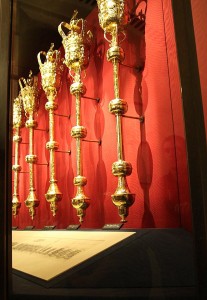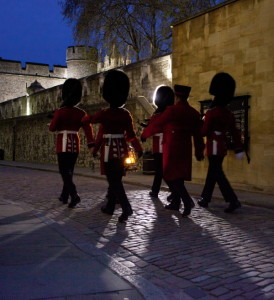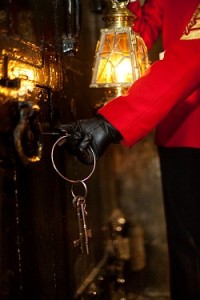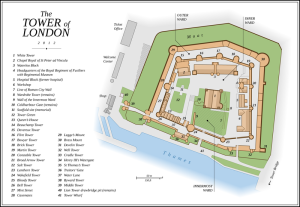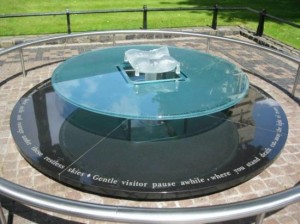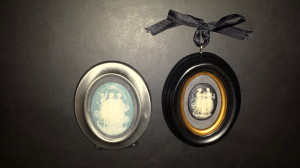There is one item in a house that we normally do not think of as a decorative piece of furniture; it is the dining room china cabinet. Most people would think the only function of a china cabinet is to store their fine china dinnerware, crystal glasses or silver serving pieces when they are not being used for a formal luncheon or dinner in the dining room. In this post I am going to show how I display the items in our china cabinet and also how I change some of the decorative items seasonally throughout the year for many different holiday styles.
Decorating a china cabinet
Shown below is a photo of how I have decorated our china cabinet and this is how it looks during most of the year and I am sure it looks a lot like a typical china cabinet display. Inside on the top two shelves of the china cabinet I have displayed pieces from our Noritake Rothschild china; each of the eight place settings has a dinner plate, luncheon plate, salad or dessert plate, soup bowl and cup/saucer. The china is very special to me because it was a wedding gift from my mother. To add some interest to the cabinet I have displayed the dinner plates on edge so the delicate floral pattern of the plate is shown, there is a groove on the glass shelf to prevent the plates from moving. I also have added eight glass and silver plate chargers that are displayed beneath each of the stacked place settings.
Displayed with the china are four sets of Tiffany crystal glasses that were a wedding present from a good friend, each set has a champagne glass and a wine glass. On the top shelf I have displayed two vintage crystal champagne glasses that were given to me by my mother. I have a very sentimental idea that when my children get married I will loan them the set as the “something old” from their maternal grandparents and it can be used as their wedding “toasting glasses”. (Unfortunately, in the photo above the bright light shining on the top shelf does not allow the vintage glasses to be seen)
Inside the china cabinet I have also displayed several silver serving pieces. On the second shelf there are two small silver candlesticks. On the bottom shelf there are two round silver serving trays and placed on top on the left is a silver pitcher and on the right is a silver and glass pitcher. In the middle of the bottom shelf there is a mirrored silver stand that is made in three sections, one square piece and two half rounded pieces. I really like the versatility of stand since I can displayed the three pieces together for one long surface or separately, the square piece can be used as one stand or the two half pieces can be joined together to form a round stand. During most of the year I displayed a silver oval-shaped covered serving piece on the top of the silver stand using all three pieces. Shown below are two photos of how I have used the mirrored silver stand in other displays. The photo on the right shows the stand used during the fall/winter season, I have displayed a set of three Currier and Ives porcelain house complete with small pine trees and several figurines. The photo on the left shows the stand when it was used a couple of years ago on the dining room table as part of a New Year’s Party buffet, displayed on top of the stand is a beautiful floral arrangement of white poinsettias and crystal sprays in a silver bowl. (For more information and photos about the other decorations for the party, please check out the Décor post New Year’s Party decorations)


The last decorative items that are displayed in the china cabinet are several Napoleon Capodimonte porcelain rose figurines. On the top shelf is a Napoleon white porcelain rose figurine which I had given to my mother as a birthday present many years ago because white roses were her favorite flower. When she died recently the piece came back to me and it is displayed near my mother’s vintage glasses. On the second shelf I have displayed another Napoleon porcelain rose figurine, the cluster of roses are a beautiful pale pink and the figurine is set on a small silver candleholder which I’ve used as a stand. On the bottom shelf of the china cabinet I have displayed two more Napoleon porcelain rose figurines, these two figurines are a lovely deep shade of pink roses with stems and they are placed on top of the round silver trays on the left and right.
Seasonal china cabinet decorations
When decorating a china cabinet for the different holidays you will want to take into consideration that it is already filled with china, crystal and silver pieces so select just a few simple but elegant decorative seasonal items the compliment the colors of the china. I am lucky because the Nortitake Rothschild pattern of my china is very neutral in color and the season items that I use blend very well with the other items already on display.
Spring/Easter –
Several years ago I found four large silver and white glass eggs in a local retail store and for the Easter holiday I set the eggs inside four of the Noritake china tea cups which sit atop the stacked china place settings. I also have collected a Hallmark series of Peter Rabbit themed ornaments over the years and I display these around the china cabinet resting against some of the teacups. I think these Easter decorations add the perfect touch to decorating the china cabinet for the season.


Patriotic –
For the Fourth of July holiday I was looking for some patriotic decorations for the china cabinet. I wanted something that would match the elegance of the china, crystal and silver items already displayed in the cabinet. A few years ago I had purchased four large stars made out of mirrors and trimmed in silver and they looked wonderful placed in the china tea cups and are a simple and the perfect patriotic touch.
Fall/Autumn –
Once again I was looking for simple yet elegant decorative items to add to the china cabinet for the Halloween and Thanksgiving seasons. I couldn’t find anything that I like in my local retail stores so I decided to make them. I found two small ceramic pumpkins in my local craft store that I painted orange with green stems and decorated them with small topaz-colored crystals. I placed the pumpkins on the two of the china tea cups and they looked wonderful in the china cabinet with the light reflecting off the crystals. (For a supply list and instructions on making the jeweled pumpkins, please check out the Craft post link Jeweled Pumpkins)
Finally, when decorating a china cabinet think about using the area outside of the cabinet to incorporate some design elements for the holiday seasons. Shown below are three photos of the china cabinet decorated for the Fall and Christmas seasons. When we lived in California our dining room had very high ceiling and I wanted to take advantage of that height by decorating the top of the cabinet with a pine garland. The first photo was taken during Christmas 2002 and features the pine garland decorated with red poinsettias and holly leaves. The second photo was taken during the Fall season in 2003 and it featured the pine garland decorated with a variety of fruit and berries. The third photo was taken during Christmas 2003 and it features sugared fruit accented with a red silk ribbon. (For more information about these decorations, check out the Décor post My Christmas Decorations from Past Years)


As you can see, there are a variety of ways to decorate a china cabinet. The important thing to remember is to keep the decorations to a minimum since the china, crystal and silver are the stars of the show!!














